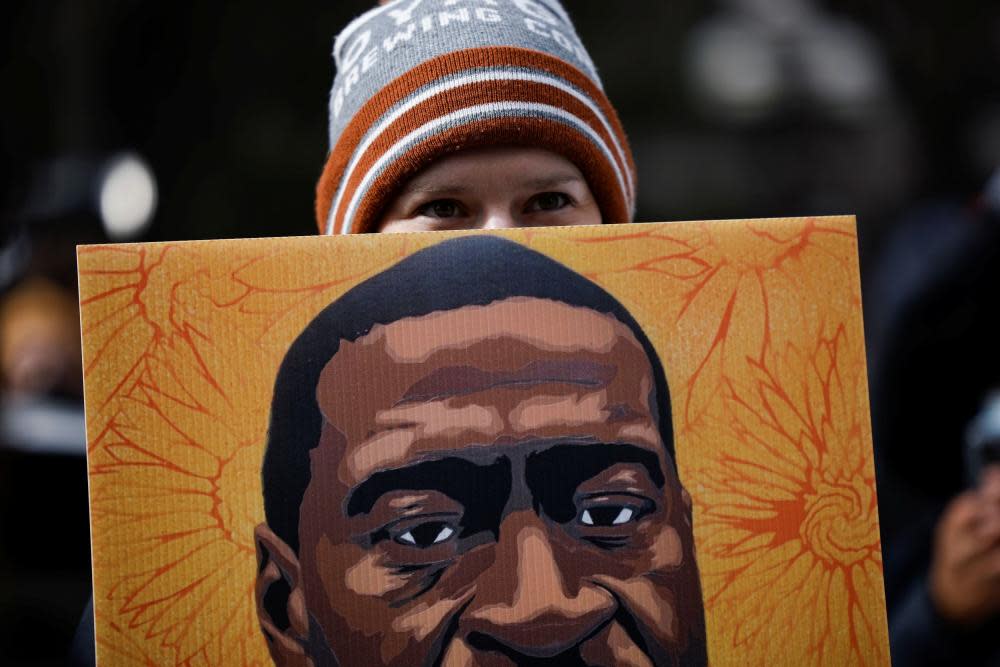Chauvin guilty verdict a landmark moment in US criminal justice history

- Oops!Something went wrong.Please try again later.
- Oops!Something went wrong.Please try again later.
- Oops!Something went wrong.Please try again later.
The trial saw 44 witnesses and 15 days of testimony. And, in the end, less than a day to decide that Derek Chauvin, the white former Minneapolis police officer, was guilty of murdering George Floyd.
It is a landmark moment not just in the history of US policing and criminal justice, but around the world. George Floyd’s death came to embody the struggle for racial justice and equality in so many ways they are impossible to condense: from forceful calls for police reform in Minneapolis and new legislation in Washington, to a reckoning on the history of British imperialism in the UK and a resurgence in activism over Indigenous deaths in custody in Australia.
Related: Tell us: are you a Black parent talking to your children about US police violence?
The evidence had always been overwhelming. But despite the multitudes of exhibits displayed at trial, it was that single cellphone video, shot by a teenage girl who wept on the stand as she describing witnessing George Floyd die, that continues to most vividly depict the details of Derek Chauvin’s crimes.
Floyd calls for his mother. He tells the officers who pin his body to the pavement for nine minutes and 29 seconds that he cannot breathe. And still Chauvin presses his knee into Floyd’s neck, his hands in his pockets and sunglasses perched on his head, a use of fatal force that continued for minutes after officers could no longer feel his pulse.
As prosecutor Jerry Blackwell told jurors on Monday, after they had heard from the defense that George Floyd had died as a result of his enlarged heart.
“… you know the truth. And the truth of the matter is, that the reason George Floyd is dead is because Mr Chauvin’s heart was too small.”
Securing a conviction in the rare instances that officer-involved fatalities make it to criminal trial has always been an uphill battle for prosecutors. Law enforcement officials in the US are endowed by a swath of protections; from ambiguous legal definitions over the proportionate use of force, to powerful police union agreements, and the many biases that stem from fundamental conflicts of interest in the system.
But from the moment the trial of Derek Chauvin trial began, it was clear that these proceedings were different from many that had come before.
A number of senior officers from the Minneapolis police department, including the force’s chief of police, Medaria Arradondo, took to the stand to decry Chauvin’s actions on 25 May last year. The testimony was both damning and unprecedented.
“To continue to apply that level of force to a person proned out, handcuffed behind their back – that in no way, shape or form is anything that is by policy,” said Arradondo.
Related: ‘I cried so hard’: the teen who filmed Floyd’s killing, and changed America
It left redundant later arguments by outside defense witnesses, namely Barry Brodd – an expert who regularly testifies in defense of police, and who described Chauvin’s near 10-minute fatal restraint as justified and objectively reasonable.
It also sets a precedent for other officer-involved fatalities that make it to trial: an expectation that police who are criminally charged over use of force may face testimony from their former superiors.
And yet, for all the weight this verdict carries, there are many things it is not.
It does not mark the end of disproportionate deadly force against African American men in the US. Just one week ago, in the Minneapolis suburb of Brooklyn Center, 20-year-old Daunte Wright was shot dead by police during a traffic stop less than 10 miles from the courthouse where Chauvin stood trial.
It underlines the fundamental complexity of US law enforcement: America’s sheer volume of police departments. There are 18,000 in total, each with their own use of force policy, training procedure and culture. Despite Brooklyn Center being just a few miles from downtown Minneapolis, the suburb has its own police force, like many other parts of the metro area.
Following the death of Michael Brown in Ferguson, Missouri, in 2014, Barack Obama’s taskforce on 21st-century policing published a detailed report and produced a set of 59 recommendations. Many were pragmatic, but among the most prescient remains a key and, as yet unrealized, suggestion for a cultural paradigm shift in US policing. From that of a “warrior” mindset to that of a “guardian”. With such a decentralization of power in US law enforcement, it is hard to see how such a sweeping change is possible to realize immediately.
Neither is the verdict true justice, in the words of many close to the Floyd family.
Outside the Hennepin county courthouse, in the bitter cold, Floyd family attorney Justin Miller was blunt in his assessment.
“What is justice when you lose a loved one? When you don’t have your father or your brother or your uncle anymore? I don’t really think there is justice. I think that that’s a term we throw around too loosely,” he said. “I think that it will be closer to being fair if this guy [Chauvin] gets as many years in jail as he can. But it’s not justice, because George Floyd is never coming back. And his daughter will never have her father again.”

